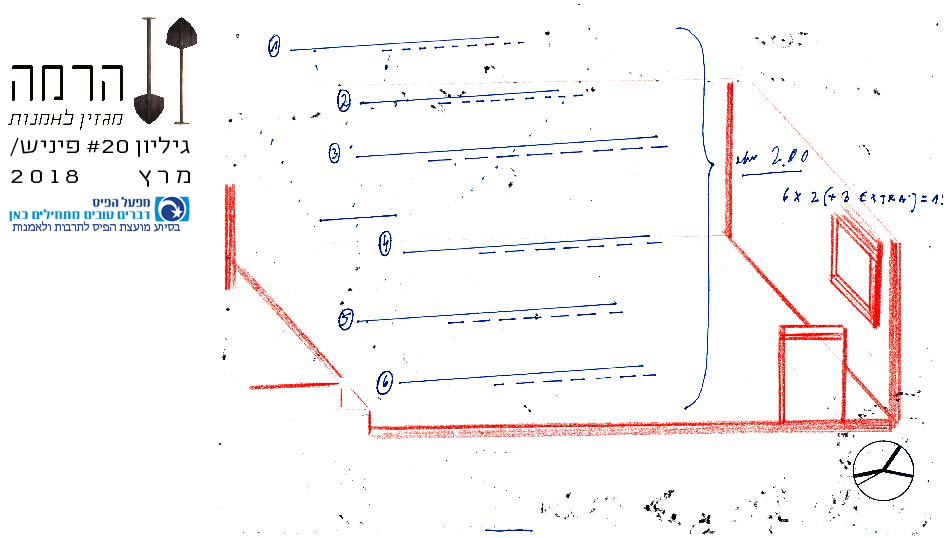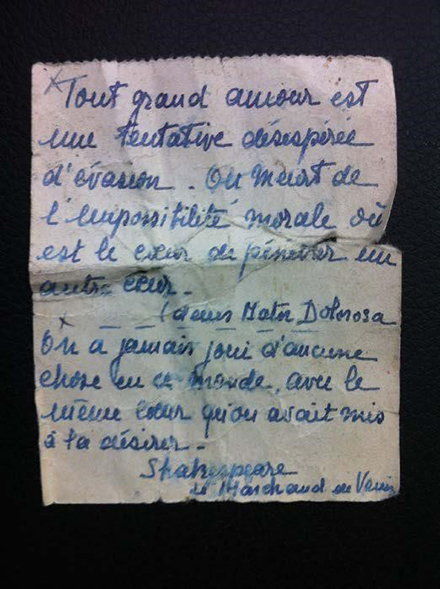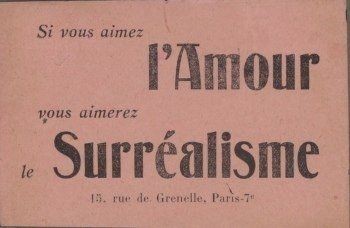Mad Love
Laura Schwartz
Benjamin Mecz’s installation On n’a Jamais Joui, 2015, is a found object: a paper note the artist picked up from the streets of Paris. The sheet is placed within a plexiglass case which stands on a wooden structure. The installation is wobbly since only two legs instead of three support the construction. This work was shown for the first time during “La Confidentielle du YIA Art Fair” at the Bastille Design Center, Paris, 2015
Benjamin Mecz, On n’a Jamais Joui, 2015, wood, plexiglas, velvet, paper, 84x15x15 cm, Estate of the artist
The hand-written note is uneasy to decipher, though it seems to be two quotes; One writes : “Any great love is a desperate attempt of escaping. We die of the moral impossibility that our heart can not penetrate another heart. – Mater Dolorosa”. The other: “We never enjoyed anything in this world with the same heart we put to desire it. – Shakespeare, The Merchant of Venice”
To the best of my knowledge, it appears that the quotes aren’t real. I couldn’t find any iteration of those sentences, nor even a mention that would be close to them, neither in Stabat Mater Dolorosa, nor in The Merchant of Venice. Thus, this fragment of found paper reveals an aura of mystery. Who wrote it? Why faking quotations? Was it addressed to someone who threw it away in the street before Mecz found it
The only thing one can be sure about is that the person who wrote it was thinking about love and sexuality. Indeed, in French, both sentences involve a clear reference to sexual desire and anxiety. Consequently, Mecz decided to title the work by the opening line of the second quote, On n’a Jamais Joui, which in French bears two significations: “We never enjoyed” and “We never ejaculated”
Benjamin Mecz, On n’a Jamais Joui, 2015, Detail
Therefore, the installation raises the issue of its recipient. As a matter of fact, the artist found a personal note in the street and turned it into a piece of art, thus making it public. Always on the edge of falling down because of its missing leg, the work contemplates the fact that the sender and the beneficiary of the paper are missing. The title itself refers to a missed opportunity. Mecz took the responsibility of becoming the recipient of that note
The very act of finding an object, and giving sense to it by transforming it into a work of art is extremely close to André Breton’s and the Surrealists artists ethos. Indeed, Mecz’s work is a perfect example of what Surrealists called an “objective chance”. Breton defined this expression as “all the facts which, each time, present the appearance of a signal, without it being possible to say exactly what signal[1].” In other words, an objective chance is merely a coincidence. When most people wouldn’t see, or wouldn’t care about the note laying on the ground, Mecz picked it up, and made something out of it. The artist could only believe that such an extraordinary event -him finding this note- meant and revealed something. This is why he carefully kept it, and took the precaution of sealing it in a case
May it be spontaneous encounters or chance findings, the Surrealists believed that everyday details make sense and have a bigger purpose. By living his life at the most, which is to say, by opening himself to those findings, the artist radiates unto others. In that sense, On n’a Jamais Joui, is a worthy heir of the Surrealists vision on art and life. Life in itself is a piece of art as long as one pays attention to the signals it sends us. When succeeding in moving out of the familiar routines and mindsets, the artist can open himself (disponibilité in French) to meeting his objective chances. In other words, this state of mind obeys to the same process as falling in love: everywhere we see signs of the object of our desire, and suddenly, everything makes sense. Love, as coincidences, happens when one encounters something -or someone- and links it to the transcendental purpose of his own beliefs
Furthermore, in that acceptation, art -life and love, which are in the end three different words to describe the same feeling, is a collective act. It can only function and make sense when other people are tuned to the same poetic rhythm and opened for the same lightings. When there is a sender, and a recipient
If you love LOVE You’ll love SURREALISM, Surrealist flyer, 1924
[1] André Breton, Nadja, Paris : Gallimard, 1996, p. 92
Albeit the fact that On n’a Jamais Joui isn’t at first a manufactured item, it is still very close to a ready-made. It’s an object turned into an artwork only through the artist’s signature
Although popularized by Marcel Duchamp, the first definition of ready-made was written by André Breton and Paul Éluard in Dictionnaire abrégé du Surréalisme[1]: "an ordinary object elevated to the dignity of a work of art by the mere choice of an artist."
It seems rather ambitious to shrink European’s twentieth century art history into two sentences, but ready-made artworks are without any doubt the first ‘proofs of life’ of contemporary art. Indeed, in my acceptation, contemporary art isn’t a time-related matter, but rather a paradigmatic entry. This means that André Breton, although dead in 1966, is a contemporary artist. An artist studying first year in Bezalel in 2018 is not necessary contemporary
Contemporary means that that our acceptation of art as a given took a shift. It is no longer defined by whether it is beautiful, looks like art or if it pleases the eyes; but merely by the fact that the artist who created it decided to qualify is as such. Therefore, there is practically no need to be educated or qualified to be an artist. Art happens when the artist opens himself to the myriad of encounters the world offers him and reads the signs it bears
On n’a Jamais Joui is a found paper note laying on a two legged wooden structure. It is nonetheless one of Benjamin’s work that moves me the most. Because he truly believed in chance, in spontaneity, in looking at something no one else would, and turn it into art. For him, art was first and foremost an act of love and sharing
[1] André Breton et Paul Éluard, Dictionnaire abrégé du Surréalisme, Paris : Galerie des Beaux-Arts, 1938
___
Born in Paris and based in Tel Aviv for nine years, Laura Schwartz is an independent curator, journalist, and writer
She's the founder of the platform Aleph Projectsf, The chief editor of The Cultural Guide for Jewish Europe, She writes a weekly chronicle in the French newspaper Libération, and hosts a weekly cultural show on Radio Tel Aviv



